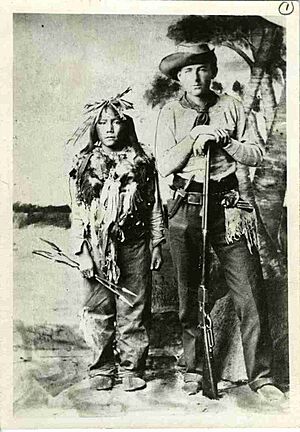Frog Lake Massacre facts for kids
Quick facts for kids Frog Lake Massacre |
|||||
|---|---|---|---|---|---|
| Part of the North-West Rebellion | |||||
 |
|||||
|
|||||
| Belligerents | |||||
| Cree | Residents of Frog Lake | ||||
| Commanders and leaders | |||||
| Wandering Spirit | none | ||||
| Casualties and losses | |||||
| none | 9 killed | ||||
The Frog Lake Massacre was a sad event that happened during the North-West Rebellion in western Canada. It took place on April 2, 1885, in a small community called Frog Lake. Young Cree men, led by a war chief named Wandering Spirit, attacked government officials, religious leaders, and settlers. Nine people lost their lives in this incident.
Contents
Why the Frog Lake Massacre Happened
The Cree people, led by Chief Big Bear, had settled near Frog Lake. This was about 55 kilometers (34 miles) northwest of Fort Pitt. Big Bear had signed Treaty 6 in 1882. However, many Cree felt this treaty was unfair. They were also struggling because the number of buffalo (their main food source) was shrinking. This led to starvation for many Cree families. Because of these problems, Big Bear started to organize the Cree to resist.
A week before the Frog Lake event, the Métis people had won a battle at Battle of Duck Lake. Also, another Cree leader, Poundmaker, was moving towards Battleford. Hearing this news, Wandering Spirit, who was the war chief for Big Bear's group, decided to gather weapons, bullets, and food from the area. The main places to get supplies were the government stables, the Hudson's Bay Company store, and George Dill's shop in Frog Lake. The Cree were very angry, especially at the Canadian government's representative, the Indian agent Thomas Quinn. They felt he was giving them too little food, which kept them hungry.
The Events at Frog Lake
In the early morning of April 2, 1885, a group of Cree led by Wandering Spirit took Thomas Quinn hostage in his home. Then, they took more white settlers hostage and took control of the community. They gathered the Europeans, including two priests, inside the local Catholic church. A church service was happening at the time.
After the service ended, around 11:00 AM, the Cree ordered the prisoners to move to their camp, which was a few kilometers away. Thomas Quinn refused to leave the town. Because of this, Wandering Spirit shot him. In the confusion that followed, eight more unarmed settlers were killed, even though Big Bear tried to stop the shootings. The people killed were two Catholic priests (Leon Fafard and Felix Marchand), Fafard's assistant (John Williscroft), and John Gowanlock, John Delaney, William Gilchrist, George Dill, and Charles Gouin.
A clerk from the Hudson's Bay Company, William Bleasdell Cameron, was one of the men gathered in the church. He had gone to the Hudson's Bay shop for an order. When the first shots were fired, he managed to escape. Some Cree who felt sympathy for him helped him get away. He went to a nearby Wood Cree camp, where the chief kept him safe.
Two women, Theresa Gowanlock and Theresa Delaney, whose husbands were killed, were taken captive. About seventy other people from the town were also taken. Some Métis people, like John Pritchard, "bought" the two widows and protected them.
The two Theresas later wrote a book about their experience called Two Months in the Camp of Big Bear. William Cameron also wrote a popular book about what happened, called Blood Red the Sun.
After the killings, some Métis captives quickly put the bodies of Fafard, Marchand, Delaney, and Gowanlock in the cellar under the church. They also bravely moved the bodies of Quinn and Gouin into the cellar of a nearby house. However, they were not allowed to touch the other victims.
On April 4, 1885, the church, the rectory, and all the buildings in Frog Lake were burned down. Only the bell tower and the cemetery were left. On June 14, soldiers arrived and buried the victims in the cemetery. During this time, the bell from the bell tower disappeared.
What Happened Next

After the Frog Lake events, the Cree moved towards Fort Pitt. The Canadian government sent soldiers and police to the area to stop the rebellion. The rebellion was eventually put down.
Several Cree men, including Wandering Spirit, were put on trial for the killings at Frog Lake and Battleford. They were not allowed to have lawyers. Judge Charles Rouleau sentenced eight of them, including Wandering Spirit, to death by hanging. This was the largest mass hanging in Canadian history and happened on November 27, 1885.
Even though Chief Big Bear had been against the attack, he was charged with treason because he had tried to organize resistance among the Cree. He was found guilty and sent to the Manitoba Penitentiary for three years.
Remembering Frog Lake
Frog Lake became part of the province of Alberta in 1905. In 1923, the place where the attack happened was named the "Frog Lake National Historic Site." This site is where the Cree uprising took place in the District of Saskatchewan, which was part of the North-West Territories back then. Parks Canada says the historic site is quite large, but they only own a small part of it, mainly a graveyard. A stone monument and a federal plaque were put there in 1924.
In 2008, Christine Tell, a provincial minister, said that the 125th anniversary of the 1885 Northwest Resistance in 2010 was a great chance to share the story of the Métis and First Nations peoples' struggles with the government. She noted how these events helped shape Canada into what it is today.
See also
 In Spanish: Masacre del lago Frog para niños
In Spanish: Masacre del lago Frog para niños

